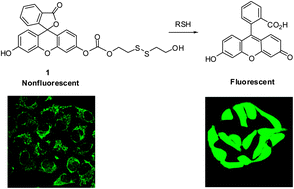A fluoresceinylcarbonate-based fluorescent probe for the sensitive detection of biothiols in a HEPES buffer and its cellular expression†
Abstract
A fluoresceinylcarbonate-based fluorescent probe (1) with a disulfide bond was designed for the detection of biothiols in an aqueous solvent. The probe showed a more rapid and sensitive response to biothiols than other various amino acids through the disulfide bond cleavage and the subsequent intramolecular cyclization. When glutathione was added to the probe, fluorescence of 1 was significantly enhanced and was observable with the naked eye and in living cells.


 Please wait while we load your content...
Please wait while we load your content...